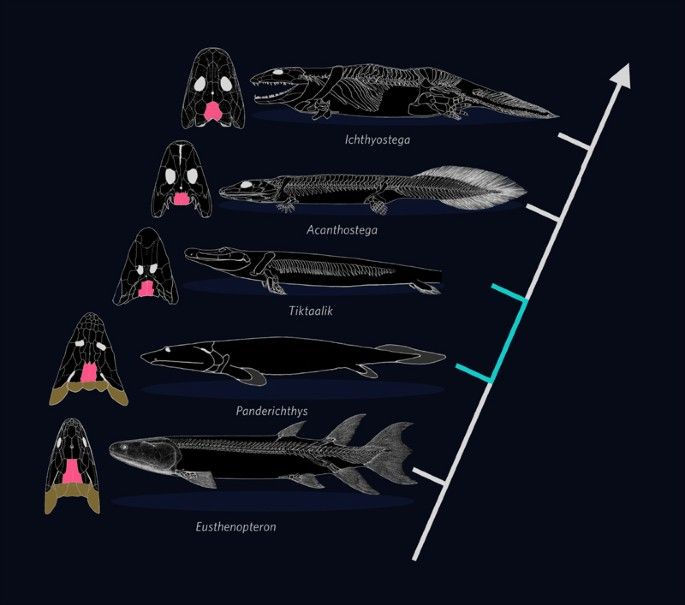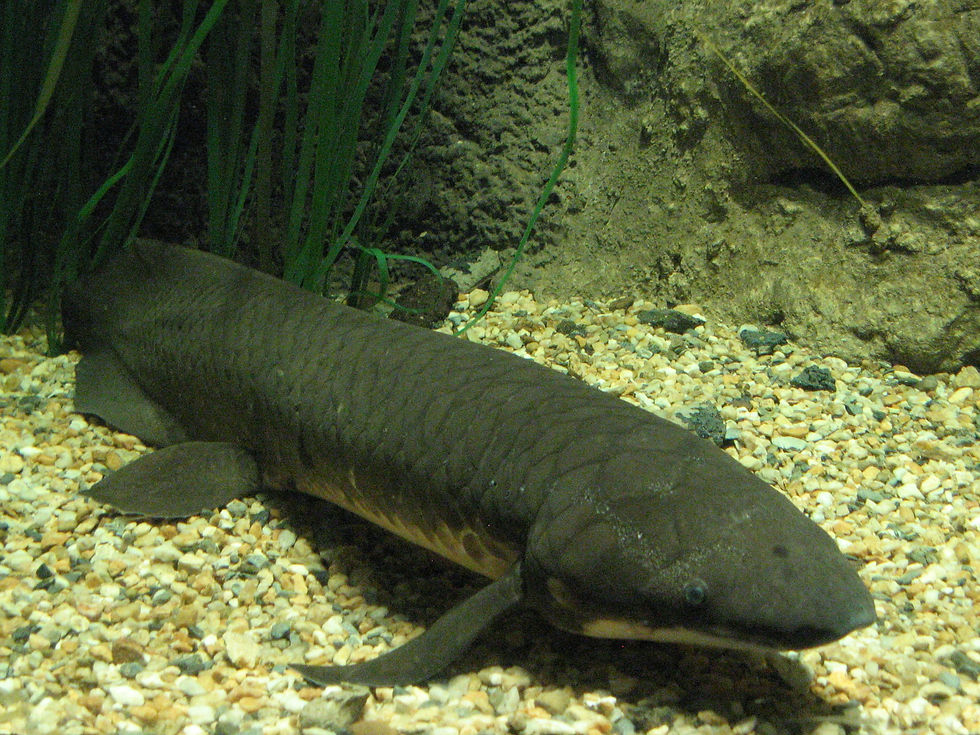Did you know... snakes may once have had legs?
- ML
- Aug 29, 2022
- 5 min read
Updated: Sep 25, 2022
As descendants of four-legged terrestrial ancestors, snakes inherited the same body plan as, for example, crocodiles, birds, and humans - including legs. What happened to theirs?

Have you ever seen a snake stuff its mouth with hands full of juicy mice like the German kid in Charlie and the Chocolate Factory (with chocolate, not mice)? Me neither. Snakes feed, move about, climb, and even swim entirely without the aid of legs or arms. They have adapted perfectly to a limbless life.
You may be surprised to learn, then, that the ancestors of today’s snakes may indeed have done all of those things, minus the chocolate, perhaps. How? They did have limbs. To understand why and what happened to them, we need to travel back in time several hundred million years and consider their evolutionary origins.
Snakes belong to a wider group of animals that biologists refer to as vertebrates. These include fish, amphibians, reptiles, birds, and mammals (including us humans). Vertebrates share a common ancestor: primitive, eel-like creatures such as Haikouichthys and Myllokunmyngia which appeared as early as 518 million years ago during the Cambrian period. These prehistoric, ocean-dwelling 'eels' already possessed several anatomical features that would become key characteristics of the entire group: a clearly discernible head, a tail, and a rod like structure along the backside of their bodies, as well as a tube of nerve cells running parallel to it. Together, these last two would form the defining feature of nearly all vertebrates (hagfish being the lone exception): the vertebral column, or more commonly known as spine or backbone.
First steps on solid ground
However, it wasn't until more advanced fish such as the armoured but still jawless ostracoderms emerged about 500 million years ago that paired appendages first appeared in the form of fins. Then, around 120 million years later, these fins became limbs in members of the lobe-finned fishes - a subgroup that had diverged from the main fish lineage around 418 million years ago and that includes the modern day lungfish and the 'living fossil' coelacanth. Researchers believe that the incremental change from fins to limbs - well documented by fossils of species representing transitional evolutionary stages, such as Tiktaalik, Acanthostega, and Ichthyostega - coincided with the transition from a water-based to a land-based lifestyle.


Once the likes of Ichthyostega had successfully colonised land - marking the beginning of four-legged vertebrates (tetrapods) - gills were initially at least partially retained in the first amphibians before they were eventually lost by the time synapsids (ancestors of all mammals) and sauropsids (ancestors of all reptiles and birds, including lizards, snakes, and dinosaurs) appeared. Before long, feathered dinosaurs like Archaeopteryx took to the air as the ancestors of modern birds, whereas synapsids gave rise to mammals and, eventually, us.
It is because of this shared ancestry that nearly all vertebrates share the same fundamental body plan, no matter if fish, crocodile, or ape: a head, a spine, a tail, and in the vast majority of species, four appendages either as fins (such as in fish or marine mammals like whales, seals and sea lions) or as limbs in terrestrial vertebrates. But, if snakes inherited the same body plan as fish and limbed vertebrates, where are their legs?
Scientists long believed that the immediate ancestors of snakes were terrestrial, four-legged lizards which incrementally saw their thorax (chest) elongate and their legs degenerate around 90-120 million years ago, resulting in the typical snake-like anatomy we see today. And with the astonishing discovery of the fossilised remains of Tetrapodophis in 2015, seemingly a four-legged snake that lived during the early cretaceous period around 130 million years ago, the theory appeared to have been confirmed in stunning fashion. However, subsequent analyses of the specimen - most recently in 2021 - concluded that Tetrapodophis was in fact a lizard and unlikely to be a direct ancestor of modern snakes; those, it is thought, had already lost their front limbs by the time Tetrapodophis roamed its home in what today is Brazil.

A recipe for missing legs
To understand the underlying mechanisms that had lead to limb degeneration in snakes, researchers turned their attention towards the evolutionary genetics of vertebrate limb development, from embryo to adult. Curiously, vertebrate embryos from different species are virtually indistinguishable during the earliest developmental stages. It is only upon further development that anatomical differences, like skeletal size or shape, manifest. The reasons for this are differences in the timing, localization, and extent of activity of developmental genes.
The researchers' mission was guided by findings from young snakes as well as from several evolutionarily primitive snake species, such as pythons and boas. While adult snakes don't have legs, young ones, that is during the first hours of the embryo's existence, do; kind of anyway. The same cell populations that in limbed vertebrates give rise to arms and legs also show genetic activity of developmental genes associated with limb development in such early stage snake embryos. Moreover, snakes like boas and pythons, while without visible legs, even develop and retain into adulthood remnants of limb bones, known as vestigial legs and visible as bony spurs. These clues suggested that the ability to grow appendages may not have been entirely lost in snakes, rather it appears to have somehow been stunted or silenced.

To pinpoint the genes that lie at the heart of snakes' limblesness, the researchers compared regions of the vertebrate genome known to be involved in limb formation. They found that snakes carry various disabling mutations in a genomic region known as the ZPA regulatory sequence (ZRS), a gene regulatory element that acts as an enhancer for the sonic hedgehog gene (Shh). Shh expression is intricately timed, modulated, and localized to ensure correct limb development. In humans, for example, disruption in the ZRS region (e.g., due to mutations) causes a range of limb deformations, including polydactyly (extra fingers or toes) or elongated thumbs.
Thus, it appears that in snakes the accumulation of disrupting mutations in the ZRS has led to the cessation of Shh expression very early during embryonic development, resulting not merely in limb deformation but in the arrest of limb formation altogether. Yet, in python embryos, researchers found that Shh activity persists for up to 24 hours after the beginning of the embryo's existence; long enough to lay down the foundation for legs, but too short to fully develop them. All that hese snakes are left with are the rudimentary leg bones of their hind limbs.
To confirm that it was indeed the snake ZRS and the associated cessation of Shh activity that causes limblessness in snakes, the researchers went one step further and tested what effects snake ZRS would have on limb development in limbed animals. To do this, they genetically modified the genomes of laboratory mice to contain snake ZRS instead of mouse ZRS - and voila: legless mice! In contrast, when they substituted mouse ZRS for human and even for fish ZRS, the mice's leg development was perfectly normal.
There you have it. Snakes once had legs, and evolution 'took' them away. I'll toast that a similar fate does not lie in our future. Although, snakes don't seem too unhappy with their legless existence. But who knows, perhaps they would complain if they could?
Unlinked cited literature
Ahlberg, P., Clack, J. A. A firm step from water to land. Nature. 440, 748-749 (2006). Link



Comments